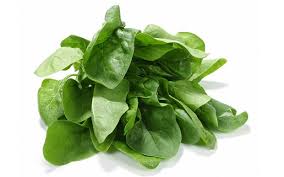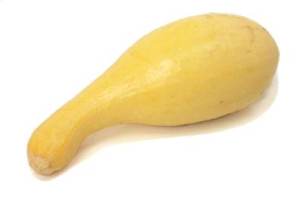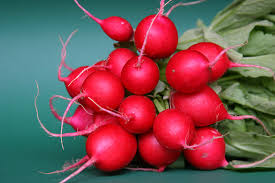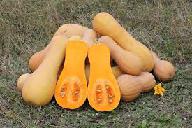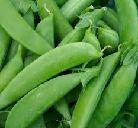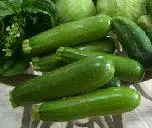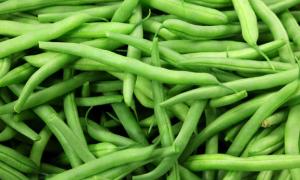- Location: OECC and OPL
- Scientific Name: Spinacia Oleracea
- Planting Instructions: Spinach is a cool-weather vegetable (preferring temperatures between 35 and 75 degrees F but tolerating temperatures as low as 20 degrees F after they are well rooted). It grows most quickly in fertile, well-drained soil. Plant about about 4-6 weeks before the last frost in the Spring and again 6-8 weeks before the first frost in the Fall. Space seeds 12 inches apart. Though it prefers full sun, it can grow in partial shade. In the Spring, plants will grow tall and bloom (called “bolting”) as soon as the days are longer than 14 hours. Spinach leaves are ready to harvest as soon as they grow big enough to eat. Harvest by removing only the outer leaves and allowing the center to still grow. In Spring, when the plants are about to “bolt,” uproot the entire plant so you can eat the leaves before they become bitter.
Vegetables
Summer Squash
- Location: OECC and OPL
- Scientific Name: Cucurbita Pepo
- Planting Instructions: Sow summer squash seeds in prepared beds or hills after all risk of frost has passed. Stop planting summer squash 12 weeks before your average first Fall frost date. Plant in a sunny area with fertile, will drained soil. Plant seeds 8 inches apart and 1 inch deep. Water well. Summer squash blossoms are edible, and you can harvest fruits from baby-sized up until they toughen with age. Harvest at least twice a week, using a sharp knife to cut fruits (leave a small stub of stem attached). Promptly wash fruits in cool water and store.
Radishes
- Location: OECC + OPL
- Scientific Name: Raphanus Sativus
- Planting Instructions: Radishes are a hardy, cold-season vegetable. They can be planted in both Spring and Fall. Plant 4-6 weeks before the average day of last frost for Spring, and 4-6 weeks after the average day of first frost for Fall. Plant seeds 1/2 inch – 1 inch deep, and 1 inch apart, in rows 12 inches apart in well drained soil with a lot of moisture. Radishes need a lot of sun – make sure they are not even shaded by neighboring plants. Plant consecutively every few weeks while the weather is still cool for continuous harvest. Radishes grow very quickly and can be ready for harvest as soon as three weeks after planting. Do not leave in the ground too long after plants have reached maturity, they will deteriorate quickly. Cut the tops off short, wash the radishes thoroughly, and dry.
Winter Squash
- Location: OECC and OPL
- Scientific Name: Cucurbita
- Planting Instructions: Winter squash can grow from a size large enough to be one serving on up to serving a table full of people at 12 pounds. Will ripen 80 to 110 days after planting. Space 5-6 feet apart and at least 12-inches deep. Plant in early Spring.
Snow/English Peas
- Location: OECC and OPL
- Scientific Name: Pisum Sativum var. Saccharatum
- Planting Instructions: Can be eaten as Snow Peas or English Peas. To use as Snow Peas, harvest really young before pods fill out; just crunch on the whole thing–skin and all! To use as English Peas, let the peas inside get big, and then shell them, eating the peas separately from the skin. Plant in early Spring–in cool, damp weather. Space plants 5 inches apart. Young pea plants can survive a light frost, so plant before last frost hits. However, be prepared to protect flowering plants from a late frost–it will hurt flowers and mess with pod development. Weed often, and mulch as best you can. Peas don’t need a trellis, but pods will be easier to pick when vines are upright. If you want to use a trellis, insert it prior to planting. To make a trellis: Use netting, stakes, and string, or a wood frame trellis covered with chicken wire or metal fencing or a collection of twiggy branches stuck into the ground among the plants. Peas attach by tendrils–tiny stems that curl and encircle supports. Tendrils quickly wrap around slender supports to hoist vines skyward.
Zucchini
- Location: OECC and OPL
- Scientific Name: Cucurbita Pepo
- Planting Instructions: Zucchini is a type of summer squash, so soil needs to be very warm for it to grow (at least 60 degrees F). Plant Zucchini earliest about 1-week after the last Spring frost and latest mid-summer. If you wish to plant earlier, use starter pots and transplant when soil is warm enough. Plant 3-feet apart, 1-inch deep, in very moist soil, but not soggy. Make sure beds receive as much sun as possible. Squash are heavy feeders, so ensure that soil has plenty of nutrients. Water deeply once a week–make sure soil at least 4-inches down gets wet. Harvest when small and tender–usually after about 60 days.
Green/String Beans
- Location: OECC and OPL
- Scientific Name: Phaseolus Vulgaris
- Planting Instructions: Plant Green/String Beans in late Spring, and let mature throughout the extreme heat of Summer. Do not plant in shade. Green/String Beans come in two varieties: bush and pole. Plant bush beans in single rows 4-6 inches apart. Plant pole beans 6 inches apart with trellising. (You can make trellises out of string, stakes, chicken wire etc. Just make sure to stabilize vines with a tall and sturdy material for tendrils to cling to.) Bush beans begin producing before pole beans, and often come in all at once. Plant bush beans in waves to ensure continuous harvest. Plant in hot, moderately-rich soil, 1-2 inches deep. Water immediately and regularly until seeds sprout. Pole beans may need some initial help climbing your trellises. You should coax the vines around your trellises until they are able to climb and wind themselves. Bush beans will grow about 2-feet tall and 1-foot wide; pole beans can grow almost 10-feet tall. Bush beans take 50-55 days to mature; pole beans take closer to 60 days. Harvesting is an ongoing process–the more beans you pick, the more the plant will grow. You can start to harvest any time, but gardeners usually wait until pods are firm and can be snapped. Make sure to harvest before pods become thick as a pencil and before you can see beans bulging inside pods, however, as these descriptions mark an over-ripe bean. Harvest by gently pulling each bean from the vine.
Cucumber
- Location: OECC and OPL
- Scientific Name: Cucumus Sativus
- Planting Instructions: A tropical vegetable, cucumbers thrive when the weather is hot and water is plentiful. Plants are so sensitive to frost that they shouldn’t be put in the ground until soil temperatures are reliably in the 70 degree F range (at least a solid 2-weeks after last frost). Cucumber plants grow in two forms–vine and bush. Vines yield more cucumbers throughout the growing season. Bush plants are better for smaller, more compact gardens. Increase bush yields by planting several crops in succession, 2-weeks apart. Plant seeds in nutrient-rich soil, 36-60 inches apart depending on variety. Trellising for vine plants is optional, but not necessary. If you choose to trellis your cucumber vines, space plants 1-foot apart. You can make a 12-18 inch diameter trellis with wire fencing, or string and wooden posts. 4-5 feet of welded wire will support 2-3 plants. If weather is unseasonably cool, cover plants in the first stages of their growth to keep them warm. Other than temperature, cucumbers grow fast and don’t demand a lot of care. Water 1-inch per week and spread evenly. Cucumbers are ready to harvest whenever they’re big enough to use. Check daily, because they grow so quickly. Vines produce more cucumbers the more you harvest. To remove the cucumber, use a knife or scissors, cutting the stem just above the cucumber. Don’t just pull them off. And make sure not to let the cucumbers over-ripen, because they will become bitter and will keep the vine from producing more. Yellowing at the blossoming (bottom) end of the cucumber signals over-ripeness. Harvest immediately.
